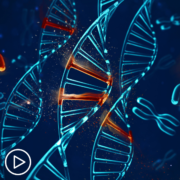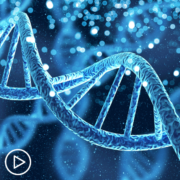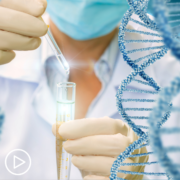Tag Archive for: targeted therapies
Elevate | What You Should Know About Your Role in AML Treatment and Care Decisions
Elevate | What You Should Know About Your Role in AML Treatment and Care Decisions from Patient Empowerment Network on Vimeo.
Related Resources:
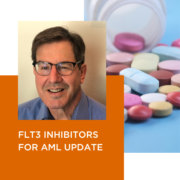
|

Thriving With AML | Advice for Setting Goals and Making Treatment Decisions |
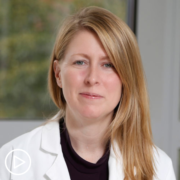
Expert Advice | Managing AML Symptoms and Treatment Side Effects |
Transcript:
Katherine Banwell:
Hello, and welcome. I’m your host, Katherine Banwell. It’s no secret that the quality-of-care patients receive can vary, and patients who are educated about their condition and involved in their care may have improved outcomes. That’s why the Patient Empowerment Network created the Elevate series, to help AML patients and their care partners feel well-informed when making treatment decisions with their healthcare team.
In today’s program, an AML expert will join us to share advice for accessing better overall care. Before we get into the discussion, please remember that this program is not a substitute for seeking medical advice. Please refer to your healthcare team about what might be best for you. Well, let’s meet our guest today. Joining us is Dr. Gail Roboz. Dr. Roboz, would you please introduce yourself?
Dr. Gail Roboz:
Absolutely. Thank you so much for having me. My name is Gail Roboz. I’m a professor of medicine and director of the clinical and translational leukemia programs at Weill Cornell Medicine and the NewYork-Presbyterian Hospital in New York City. Thank you again for having me.
Katherine Banwell:
Well, thank you so much for joining us today. We really appreciate it. I’d like to start by discussing your role as a researcher. You’re on the frontlines for advancements in the AML field. What led you here, and why is it important to you?
Dr. Gail Roboz:
So, I’m actually asked that question quite frequently, because AML is a challenging, difficult, scary disease, and people don’t necessarily assume that somebody in medical school would gravitate toward it.
But I have to say that what is incredibly fascinating back then and now about leukemia is the continuous access to the disease. Patients will maybe giggle or groan as I’m saying that, because you can get a blood sample really anytime. You can even get a bone marrow sample anytime, although patients don’t enjoy that so much.
But from a research perspective, it is absolutely extraordinary to be dealing with a disease where you can, in real time, truly run back and forth to a laboratory and see what’s happening, what is the new drug or the old drug doing, what’s happening with the patient, and I would say that from a fascination of a medical student perspective that grabbed me then and still does today.
Katherine Banwell:
When it comes to choosing therapy for AML, it’s important to work with your healthcare team to identify what will work best for you, the patient. So, I’d like to know how you define shared decision-making.
Dr. Gail Roboz:
The problem with AML sometimes is that it can be such an acute, emergency-type of presentation and urgent decision-making that I think your question is almost right out of the gate for some patients that will, “Wait, I don’t even have a minute, here. How do I build a team, do the research, look online if people are telling me that I’m in the middle of an emergency?”
That isn’t always the case for acute leukemia, but it sometimes is. I think that what happens in AML in particular for patients is a building of knowledge and a building of the team, and figuring out, first of all, where am I when I am being told this diagnosis, and is it really an emergency? Do I have to make decisions really right now, because is it life-threatening today, I don’t have time to look around? Or do I have a minute to pause and get more information?
I definitely feel that with the Internet era and with so much connection between doctors and teams, there is much more ability to reach out instantaneously for doctors, too, to get advice on a patient who might be in a smaller hospital that doesn’t have AML experience. But I think that the first thing is to try to figure out very, very quickly, what needs to happen to me as a patient immediately, and what can wait a minute, so that I can figure out what am I being told, and what are my options?
Katherine Banwell:
Right, right. It can be confusing for patients, just finding out this new information. Part of making care decisions is setting goals. What are AML treatment goals, and how are they determined?
Dr. Gail Roboz:
I would say that leaving cure on the table from the beginning is always a good place to start, because you want to figure out, first of all, what am I dealing with? What are the actual options?
But when AML strikes, and a patient who has multiple medical conditions or comorbidities that are truly compromising function independently of the diagnosis of AML, that’s going to be a special path of what is actually reasonable for someone who is terribly medically ill or otherwise frail right from the beginning? That can be defining goals, but I think from the beginning, the best thing is to leave everything on the table. What can actually be done to make me better, first of all, to get me out of my immediate trouble? What can be done to make me better, and if I’m getting better, well, I like that, how do I stay there?
What can be done to hang on to the state of ‘better,’ which is sometimes defined as remission? In AML, the goal is to get the bone marrow working again, functioning again, get rid of the acute emergency problem, if there is one, which there may or may not be in acute leukemia.
Sometimes it’s truly an emergency, and sometimes it isn’t. But once I get better, can I stay there? What is required to keep me with a working bone marrow for as long as possible?
But once you are starting to sort through the diagnosis, you realize that saying that somebody has acute myeloid leukemia is not telling me nearly enough information. This is a disease that is what we call biologically heterogeneous, which means there are lots of different forms. It’s like saying you’re sick. What exactly does that mean? There are lots of things that can make you sick. There are lots of different subtypes of AML, and fairly quickly in most institutions, we start getting back some information specifically on the subtype and biological characteristics of the disease.
This can be very, very important in the initial treatment planning, and depending on where you are, the information that you get back can sometimes take 24 hours, 48 hours, 72 hours, a week. So, you start learning very quickly though that, “If I’m not in a complete emergency that requires instantaneous treatment, can I get back more information about the biological subtype of the disease so that I can start treatment planning of what is my best option right out of the gate?” That’s usually called induction, or the first therapy that you’re going to get with the goal, ‘getting rid of leukemia cells and getting into remission.’ That’s part one, and then everything that comes after that is about keeping you in remission.
But for the initial goal, what is the therapy that the patient needs to get to get into remission? In order to figure that out, the good news is there are a lot of different ways to slice and dice getting into remission, and actually, it used to be such a weighty decision.
Now, I would actually encourage people to – not relax, you can never use the word ‘relax’ with acute leukemia. But there are several different induction strategies for most patients that would be okay.
So, even if you get started with one strategy and you hear five days later that another doctor might do something different, there are a lot of ways to safely get into remission. I think everybody should be pleased about the fact that we’re doing much better than we used to for patients across the board, all the way from children to much older adults, to safely getting people into remission.
Katherine Banwell:
Right. So, what sort of factors then do you take into consideration when you’re choosing a therapy?
Dr. Gail Roboz:
So, out of the gate, there are the patients that I think I referred to earlier who truly, truly are in situations based on their other diseases that there are certain treatments we would just cross out right out of the gate.
If there are patients with very, very severely compromised cardiac or renal or lung function or are terribly ill from other conditions, AML doctors will right out of the gate for those patients eliminate certain treatments. But absent that scenario, what we try to look for is the biology of the disease. Not look at the age, not look at the comorbidities unless they are so severe that they make obvious certain choices.
But rather, what I like to do is say, “What kind of AML is this, and what is the best treatment that I have to get this patient into remission?” And then ask the question, “can this particular patient handle this therapy?” Sometimes, these days, there actually may be more than one route to get to remission depending on the biology of the disease, and then, if that’s the case, then I can start getting picky and look at the individual patient. Where does the patient live? Who’s the patient’s family? What other diseases has the patient been treated for?
Is there something that I can use? If I have a choice, if there are a couple of different things that might work, how do I fit the treatment to best take care of the needs of this particular patient? If I don’t have choices, then my question is, “Okay, how do I get this patient through my one therapy that I think is the truly, truly best option?”
Katherine Banwell:
Okay. I’d like to turn to test results for a moment. What sort of tests should be done following an AML diagnosis?
Dr. Gail Roboz:
We often generally recommend a bone marrow biopsy, even if we know we can make the diagnosis from a blood test, because even though the bone marrow biopsy is not the most fun test in the world, it does offer better information for follow-up care than what you can get initially from the blood.
So, every once in a while, we do have a patient for whom a bone marrow biopsy itself for whatever reason can’t be done. But almost always, we need a bone marrow biopsy, and on that biopsy, you’re going to look under the microscope and see what the cells look like. You’re going to get back standard testing, which is called flow cytometry, which is going to tell the difference between what are the different cells that you’re seeing under the microscope.
But then you’re actually going to get progressively much more fancy testing, including things called chromosomes or cytogenetics, and then ultimately, the majority of patients, if at all possible, will be having mutational testing to identify certain subgroups of AML that benefit from very particular treatments. Next-generation sequencing, PCR, fusion proteins, FISH, cytogenetics, I can go on and on with all kinds of terminology that is very confusing, even to hematology fellows, let alone to patients.
Usually, we use a combination of tests to decide, “Is this patient likely to be able to be cured with chemotherapy alone, or might this patient benefit from a stem cell transplant from somebody else after they go into remission?”
That’s basically what the prognostic scoring systems used to be asking, but now it’s a lot more complicated than that. Because even in the favorable categories, even in the adverse categories, where there used to be very little subtlety, now there is a lot of subtlety.
It’s all about defining getting into remission, and what do I give you once you’re in remission to keep you there? It’s no longer this windshield wiper thing of good, bad, transplant, no transplant. There’s a lot more to AML than there used to be.
Katherine Banwell:
I’d like to add that if you, the viewer, are interested in learning more about AML testing and treatment, PEN has a number of resources available for you. You can find these at powerfulpatients.org/AML, or by scanning the QR code on your screen.
Before we get into specific treatment types, Dr. Roboz, would you provide a brief explanation of the phases of therapy for AML? You mentioned induction therapy earlier. Would you tell us what that is?
Dr. Gail Roboz:
Yeah. So, here, too, I have to say that it’s more confusing than it used to be for the following reasons. So, historically and currently, we typically talk about induction as the first therapy that you’re going to get to get into remission.
Then, the treatment paradigm is you do something to get into remission; do some treatment to get into remission. After that, in the realm of post-remission therapy, there are different things that can happen. There can be something called consolidation, which might be another round of chemotherapy. Some patients get consolidation, some patients don’t. After consolidation, there can be a transplant.
So, you get into remission, you may or may not get a little bit of what’s called consolidation chemotherapy, and then go on to a transplant.
However, sometimes either after the transplant or after chemotherapy before ever getting or instead of ever getting a transplant, there might be ongoing treatment in a lower intensity ongoing basis that is called maintenance.
So, you’ve got to think about it as induction as what happens first, consolidation is something that happens when you’re in remission, and then maintenance usually refers to ongoing therapy that is different from consolidation.
It’s usually lower intensity, easier to take, oral types of treatment that may go on and on. And just to be incredibly confusing, it’s different from something like breast cancer, where often the patients are given, “You get six cycles of this, and then you’re done.” From AML, there’s actually often not that type of an obvious plan right out of the gate for the patient.
The answer will be, “It depends.” It depends. It depends how your treatment looks at this point in time. It depends how you look at this point in time.
So then, the patients say, “Well, aren’t you going to cure me of this? What are you doing? Aren’t you going to get rid of it?” So, historically, there are some patients who get cured with chemotherapy. They get chemotherapy to get into remission, they get some chemotherapy afterwards, and there’s a cure rate for some patients with that. The majority of patients who are cured with AML get an allotransplant, or a transplant from somebody else.
Then there’s a whole group of patients where we’re asking the question now, is it possible to get those patients beyond five years – so in oncology, five years is typically defined as cure. Can we get some patients with ongoing therapy to that past-five-year mark without a transplant? That’s in the zone of the ‘coming soon.’ Don’t have a ton of patients in that group right now, but hopefully we will.
Katherine Banwell:
You’ve mentioned some various treatment types that are used to treat AML. Can you share a brief overview of available treatments?
Dr. Gail Roboz:
So, the terminology that we use is a little bit annoying, because it is a little bit general. We say intensive and not intensive.
But historically, intensive chemotherapy referred to a combination of generally two types of agents, cytarabine (Cytosar-U) and an anthracycline, which is a class of chemotherapy, that either just those two together or in combination with sometimes a third or a fourth drug usually keeps people in the hospital for around a month. Not that the chemotherapy takes that long, but the treatment gets rid of basically a lot of cells in the bone marrow, good guys and bad guys, and it takes about three weeks for those normal cells to recover.
So, a standard intensive induction for AML is often around three to four weeks in the hospital, somewhere between three and five or so days of chemotherapy up front, depending on exactly what the protocol is. The classic regimen is actually still called 3+7, three days of one drug, seven of the other. But there are many variations of that that work.
The chemo is then stopped, the patient hangs out in the hospital, very frequently getting transfusions and antibiotics, and we wait for the bone marrow to recover.
Another current path that many patients are getting – almost all older patients, with ‘older’ being defined not by a specific age cutoff, but often 75 and older, almost everybody agrees no longer gets the classic chemotherapy that I just described. At some institutions, that 75 is going down, and even 70 and 65 and above are getting a new type of therapy, mostly because the new type of therapy is working pretty well. That is a combination of something called a hypomethylating agent.
Drugs like azacitidine (Vidaza, Onureg) or decitabine (Dacogen) in combination with a pill that has changed the landscape of AML more than any other called venetoclax (Venclexta). Venetoclax is a drug that is not exclusively used for AML.
It actually was originally approved for another type of leukemia. But I think that not many people would argue with the statement that what has changed absolutely the face of AML treatment has been this drug, because it’s a BCL2 inhibitor. What it does is it actually – cancer cells and leukemia cells in particular are very, very good at staying alive.
They don’t undergo cell death, they don’t want to die, and venetoclax brings down their forcefield so that those cells can actually undergo apoptosis and die.
Venetoclax in combination with azacitidine or decitabine has transformed the care of the disease, because many patients older than 65 – and the median age of diagnosis of AML is around 68 to 70. So, many patients never were well enough to have the intensive therapy. They weren’t going into remission, and they weren’t having prolonged survival often beyond a few months.
But now, those patients do actually much better with the combination of aza [azacitidine] and venetoclax. So typically, the induction path is going to be deciding who gets an intensive therapy backbone, usually associated with long hospitalization. Who gets a less intensive backbone – by the way, that is often associated with just the same hospitalization. So, that’s why I don’t love the term ‘low intensity,’ because that implies that it doesn’t work.
It does, and it also implies that you’re not going to be in the hospital. You probably will, because in the same way as for the more so-called intensive therapies, getting into remission involves getting rid of bone marrow cells and waiting for the normal ones to recover. Even if you are a patient who is getting the venetoclax combined with the azacitidine or decitabine, which is typically called low intensity, you may very well be in the hospital for a month.
Because depending on where you live and who your family is and how sick you might be, you will probably want us to watch you carefully during that first month, but it’s worth it. Because if you have a good chance of getting into remission, remission is what makes life better and life longer. So, we want to get patients into remission, even if it means upfront time in the hospital.
Katherine Banwell:
You mentioned one inhibitor as targeted therapy, but there are a couple of others. Would you briefly tell us about those?
Dr. Gail Roboz:
So, over the years recently, we have identified certain specific targets in AML which are resulting in the addition of medications on these standard backbones. So, the target for venetoclax is something called BCL2, and actually, venetoclax probably makes all chemotherapy better. It’s kind of a controversial statement, but I’m going to stand by it. But in AML, it has been shown that the addition of venetoclax to lots of different backbones makes them work better. There are other things to hit, though.
For example, there are patients with AML who have something called a FLT3, F-L-T-3 mutation. This mutation also has specific inhibitors that are FDA-approved drugs that target specifically the FLT3 mutation, and if you have one of those, your doctor may add on a FLT3 inhibitor to either a lower intensity or an intensive backbone. Similarly, there are agents called IDH inhibitors. There are IDH1 and IDH2 inhibitors.
If I start getting into isocitrate dehydrogenase pathways on this webinar, I think everybody will click off, because it’s certainly bored all of the medical students in med school, and it’s pretty tough to understand. But the bottom line is it’s very cool stuff because that boring pathway in medical school that nobody really thought about too much is actually part of very, very, central cellular functions that are a vulnerability now that have been identified in leukemic cells that, if you hit them with these specific inhibitors, patients do better.
Now, couple of things for patients. It doesn’t mean that it’s better to have a FLT3 or an IDH mutation because the targeted therapies are available. So, a lot of patients are disappointed when they don’t have mutations. I don’t want you to think in that way. It’s not that it’s better, it’s different.
It identifies a different biology. If you have certain mutations, there are certain medications that may help you more.
That’s why I think the patients are learning quickly, too, to ask the doc – they may not remember the letters of the alphabet soup, but “Do I have something about my AML that can get one of these targeted therapies added on?” I think is a good question to think about. “Do I have something about my disease that has a specific drug that we’ve already learned makes outcomes better?”
Katherine Banwell:
There’s a new emerging therapy as well. Is it the menin inhibitor?
Dr. Gail Roboz:
I think that, in understanding different targets and different pathways, it leads me to a general statement that if you can get yourself potentially onto a clinical trial at an academic center, that is something to consider right out of the gate. Because there is a lot, a lot, a lot going on in this field right now.
What we are hoping, and the reason that I am talking to you about venetoclax and FLT3 inhibitors and IDH inhibitors, is because of all the patients who jumped onto those clinical trials and proved that those drugs are better. Some of them are my patients! I was fortunate on some of those early trials to have some real winners in patients who got onto the trials. They’re the ones who drove the success.
So, for example, menin inhibitors, which are very, very exciting, targeted agents for NPM1 and KMT2A mutations and rearrangements – these are complicated to remember as a patient, but there’s a cool drug out there that might be for you. I think that patients who really think about asking the question wherever they are, the “Hey, I just got a diagnosis of AML. Is there a clinical trial that might look good for me?” I think is a great question to ask pretty much out of the gate.
Katherine Banwell:
The symptoms of AML as well as the side effects of certain medications can vary greatly among patients. So, how do you approach symptom management with your patients?
Dr. Gail Roboz:
Patients will giggle because I repeat this line. You have to be afraid of the disease, not the treatment. I think that if you read the package insert on a Tylenol, you’re certainly not going to think you’re going to live for more than 20 minutes if you take one of those. You can certainly appreciate that, with chemotherapy drugs and including some of the novel agents that I’m talking about, if you read package inserts and look at some of the signs and symptoms and things that can happen, it’s extraordinarily overwhelming.
I think that a lot of what I do for patients is I keep them close. Because if the patient is in the hospital or coming in very frequently in clinic, I think that that everyday assessment of, “What are you experiencing?” and “What can I tell you is the disease’s fault, and what can I tell you is the medication’s fault?” is so, so important.
Especially in the newly diagnosed patients, where the disease is active. Of course, we want to try to minimize anything that we can do to make the process better for patients, more comfortable for patients, but there are certain things that we do tell people, “You’ve got to slug through this particular problem, because this is the disease’s fault.” This is different from a patient in remission, where they might be getting ongoing therapy with something, or we say, “Hey, wait a minute. You’d be feeling fine, except now you’re taking this medication. How do we minimize messing up quality of life in remission?”
Because we want you to feel great when you’re in remission. I think the real answer of that is to have a really close collaboration with the healthcare team, and for the patients to really understand – I repeat this because it’s so important. What is the disease’s fault, and what is the treatment’s fault? If there’s something that is therapy-related, do I have a substitute or do I not have a substitute?
Because if the drug is essential to get us where we need to go, well, what can we do to manage comfort and to manage symptoms until you get to the place where your marrow is working again?
Katherine Banwell:
That’s great advice, Dr. Roboz. I would like to get to an audience question that we received prior to the program. This one comes from Johanna. “How can I better understand my lab test results? What questions should I be asking my provider about those results?”
Dr. Gail Roboz:
One of the things that I would say to patients is to be careful when interpreting your own results, because I really am not exaggerating to say that patients have had absolute trauma looking at things that I look at it and say, “Oh, this looks great.” So, the first thing is, be careful being your own doctor.
The second thing though is that the author of the question has to understand that there’s going to be a tsunami of data coming in with respect to AML treatment. Sometimes in the hospital on a daily basis when you’re in the middle of an induction, there is a true – tsunami is the right word – a deluge of data, and you have to work with your team to say, “What am I following here? What’s important at this phase in my treatment? What’s the number I’m looking at?” Patients sometimes tell me, “I don’t want to know any of this,” and I’m fine with that.
I think it’s actually okay. Sometimes patients will say, “Give me guidance,” and I will be specific. Because you can actually have a leukemia induction patient where every single laboratory value is abnormal. They might be getting pushed to a device, in the morning, sitting in the hospital on your iPad, 50 abnormal results. You’re trying to battle back the disease and be positive and advocate for yourself, but there are 50 abnormal results in front of you.
I think you have to really work with the team to say, “What am I looking at today? What are the numbers that are the really important ones? There are 50 abnormal ones here; everything is getting a yellow or a red light in this. How do I go through this?”
And to appreciate, also, that at different points in the treatment, the beginning of treatment induction post-remission therapy, you’re looking for different things. So, work with your team so that you’re not assessing every single result with equivalent weight, because I think you’re going to stress yourself out.
Katherine Banwell:
That’s great advice, Dr. Roboz. Thank you. As we close out the program, I’d like to find out what you would like to leave the audience with. Why are you hopeful?
Dr. Gail Roboz:
AML is changing incredibly rapidly. And I can tell you it is a lot more fun to be an AML doctor now than it used to be, with respect to what I am offering for patients. We have always fought really, really hard to have our wins, but we’re winning more. I do think that it is a complicated space to navigate for patients, but there is room for a lot of optimism.
I think we are getting patients transplanted – patients that we never thought would ever go through a transplant or getting transplanted. Patients who never had a chance of even living more than six or eight months or living much longer than that. Is it perfect? No. Do we have as many cures as we want?
No, but there’s a lot going on. I think if patients feel that excitement, they will also feel the need to ask about those clinical trials. Because I think that for a lot of patients, clinical trials is an area where they would be worried. They’re not sure that they want to. “I don’t want to be a guinea pig,” and yet here I can say in the AML space, one after another after another drug approvals in the last several years, with the patients on those trials being awfully happy that they participated.
So, I think that it’s a very, very terrifying diagnosis. There’s nothing that I can do to take the sting out of that. But try to find yourself in an optimistic place with options that are being offered to the very, very, very best that we can do. There are patients who are listening, I’m sure, who have relapsed or refractory disease who are not feeling that optimism.
I want to address you specifically, because we don’t have enough yet. We’re trying. When you have AML that has come back or come back multiply, that’s dangerous and difficult. But for those patients in particular, try really hard to get onto clinical trials. If the drugs that we have out there – if you’ve already taken them and they haven’t worked for you or if they’re not serving you well, if you’re in good shape and the drugs that we have aren’t good enough, well, let’s see if we can get you on something that’s investigational.
Katherine Banwell:
Dr. Roboz, thank you so much for taking the time to join us today.
Dr. Gail Roboz:
Thank you for having me.
Katherine Banwell:
I also want to thank all of our collaborators. To learn more about AML and to access tools to help you become a proactive patient, visit powerfulpatients.org. I’m Katherine Banwell. Thanks for joining us today.
Advances in Targeted Lung Cancer Treatments | What You Should Know
Advances in Targeted Lung Cancer Treatments | What You Should Know from Patient Empowerment Network on Vimeo.
Dr. Thomas Marron discusses how these therapies work to treat lung cancer, how the presence of certain mutations can impact care and treatment choices, and the research being done on new therapies to target specific lung cancer biomarkers.
Dr. Thomas Marron is Director of the Early Phase Trials Unit at the Tisch Cancer Institute at Mount Sinai Hospital. Dr. Marron is also Professor of Medicine and Professor of Immunology and Immunotherapy at the Icahn School of Medicine at Mount Sinai. Learn more about Dr. Marron.
See More from EVOLVE Lung Cancer
Related Resources:

|
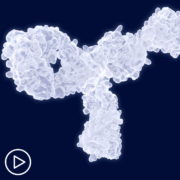
Antibody Drug Conjugates for Lung Cancer | Advances in Research |
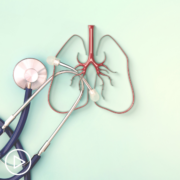
Expert Perspective | New and Emerging Progress in Lung Cancer Treatment |
Transcript:
Katherine Banwell:
Welcome, Dr. Marron. Would you introduce yourself, please?
Dr. Thomas Marron:
Sure, I’m Tom Marron. I’m the Director of the Early Phase Trials Unit at the Tisch Cancer Institute at Mount Sinai Hospital. I’m a Professor of Medicine and also a Professor of Immunology and Immunotherapy at the Icahn School of Medicine at Mount Sinai. And I’m trained as both an oncologist and an immunologist.
Katherine Banwell:
Excellent. Thanks for joining us today.
Dr. Thomas Marron:
Thank you for having me.
Katherine Banwell:
We know that the presence of certain mutations can affect lung cancer treatment options. Can you share the latest updates in targeted therapies?
Dr. Thomas Marron:
Sure, so there’s been a lot of developments in targeted therapies as of late.
Mutations in a patient’s cancer can represent a potential therapeutic target, and we have increasing numbers, every year we have new FDA approvals for typically pills that target very specific mutations and are able to either control cancer or even kill cancer. Additionally, we use DNA sequencing of tumors to identify mutations that could be predictive of a response to certain therapies. So, even though we don’t have a specific drug to target that mutation in their DNA, that change in their DNA that’s making the cancer grow, we do know that patients with certain DNA mutations do better on certain therapies than other therapies.
And so, we can use mutations specifically to help guide therapy, even if we don’t have a targeted therapy for something like EGFR mutation or a KRAS mutation. And additionally, one of the things that we do as we’re treating patients is, often times we will give a patient with lung cancer a therapy and then their cancer may respond for weeks, months, even years.
But then it might recur, or it might just start growing if it never went away entirely. And at that time, we’re oftentimes repeating the genetic sequencing, whether doing a biopsy or sometimes we can do what we call a liquid biopsy, which is just taking some blood and looking for some of the DNA from the cancer floating around in the blood.
And the reason we do that is that if you see a change in the mutations, it might represent either a change in the type of cancer or it might represent what we call an escape mutation, or an escape mechanism where the cancer that had been responding to therapy X is now not responding because it changed its DNA to overcome the therapy you were given. And that might suggest that we try a specific new therapy, or that we just change our approach entirely.
Katherine Banwell:
You’ve answered my next question to some degree, but I’m going to ask it anyway. How do these therapies work to treat lung cancer?
Dr. Thomas Marron:
So, cancer is caused by changes in your DNA. So, your DNA is your instruction booklet on how cells should grow and when they should grow. And every cell in your body theoretically has the same DNA, except for, because of a variety of things like smoking or exposure to radon or just living in a large city full of pollution. As we get older, we basically accrue more and more mutations and changes in our DNA, our instruction booklet. And while most of these changes really don’t have any sequela, and they’re not going to affect the ability for the cancer, or for normal cells to grow.
Sometimes you’ll get a mutation in a very specific gene that’s important for telling cells when to divide and when to grow and when not to grow. And you can think of it as a light switch where the light switch gets stuck in the on position and constantly, cells are growing and growing and growing and that’s when you have cancer. So, when you have these mutations, one of the approaches that we’ve been working on for the last few decades, in particular in the last few years.
We have lots of these new drugs that target these mutations, and they basically turn that on signal off. So, they disrupt, it’s like turning the light switch off. You’re disrupting the constant grow, grow, grow signal and keeping the cancer from growing. Typically, we think of these targeted therapies that do this, not as cures for cancer, at least when patients have metastatic disease, but they’re very good at controlling cancer. And some of these therapies can work for years, even a decade and control the cancer. But often times, unfortunately cancer always finds a way to outsmart us, even when we’re outsmarting it.
Katherine Banwell:
Right. Are there new mutations being discovered that can impact the future of small cell lung cancer care?
Dr. Thomas Marron:
Well, I’m not sure I would say that there’s a lot of new mutations that’ve been discovered, per se. Every time that you come in and get a diagnosis of lung cancer, we typically will take the tissue and like I said, sometimes we’ll take some blood and do a liquid biopsy and look for a slew of different known mutations.
And typically, we’ll look for anywhere from three to 500 known mutations in the cancer, even though we only have drugs to treat about 10 of those three to 500. The nice thing though is that as we learn more and more and more about these mutations and we study them, we are developing more and more drugs to address specific mutations. So, five years ago we really only had three different mutations that we could target.
Now, we have around 10 because we have all these new drugs that target very specific mutations whether they be in genes like MET or RET or KRAS or BRAS.
So, I think that while we aren’t necessarily discovering that many new genes, we’ve been looking at the genetic sequence of cancer and also, just the human genome for 20 to 30 years at this point, we’re discovering lots of new drugs that can target those specific mutations that we know patients have, but that most of the mutations we identify are not necessarily druggable targets.
Understanding Oncogene-Driven Lung Cancer: Targeted Therapy Advances and Challenges
Understanding Oncogene-Driven Lung Cancer: Targeted Therapy Advances and Challenges from Patient Empowerment Network on Vimeo.
How do the genetic mutations of EGFR and exon 20 impact lung cancer? Expert Dr. Christina Baik from Fred Hutchinson Cancer Center discusses oncogene-driven lung cancer and how it differs from other lung cancer types.
See More from START HERE Lung Cancer
Related Resources:

|

Newly Diagnosed Non-Small Cell Lung Cancer | Key Advice for Patients |

Advancing Lung Cancer Treatment: Bridging the Gap in Personalized Care |
Transcript:
Lisa Hatfield:
What exactly is oncogene-driven lung cancer, and how does it differ from the other types of lung cancer?
Dr. Christina Baik:
So in lung cancer, there are certain lung cancers where the growth of the cancer is dependent on a particular genetic abnormality. So there is one gene that makes that cancer grow. And because of that, there have been treatments that are developed against that particular genetic abnormality. So, it is referring to lung cancers that have that particular genetic abnormality. A prime example of this is lung cancers that have what we call an EGFR mutation.
That means that there is this gene called EGFR that is abnormal, and that’s making the cancer grow. Now, not everyone has a cancer gene that is driving that cancer. I would say about 30 percent or for 30 percent to 40 percent of patients would have an oncogene-driven cancer for which there may be treatments either as a standard treatment or in clinical trials. But the majority of patients do not have an oncogene, meaning that genetic abnormality where there is a targeted therapy option. So that’s the distinction we make. And I know this term or phrase is used a lot, but that’s what it means. And if you want to know if one has an oncogene-driven lung cancer, you would know based on the genetic test results.
Lisa Hatfield:
Okay. Great. Thank you. And just for clarification too, the genetic mutations are found in the cancer cells, not in their body, the cells? So that’s what the genetic testing is done just on the cancer cells. Is that correct?
Dr. Christina Baik:
Yes. Yes.
Lisa Hatfield:
Okay, great.
Dr. Christina Baik:
Thank you for clarifying that. That’s a very important distinction.
Lisa Hatfield:
Yeah. Thank you. So that leads right into the next question, and it’s kind of a lengthy question. And this person is asking, “Dr. Baik, you have done considerable research around EGFR exon 20 insertion mutations in non-small cell lung cancer, considering their association with poor survival outcomes, what are the survival implications of having EGFR exon 20 insertion mutations compared to other types of EGFR mutations?”
Dr. Christina Baik:
Now this gets a bit complicated, but not all EGFR lung cancers are the same. And there are patients who have what we call EGFR mutation that is a classical mutation. And I throw out that term, because that’s how it’s written on the Internet and a lot of papers. And then, so that’s one group, and the other group are patients who have this exon 20 insertion mutation. And the reason these are separated is because the treatments that work very well in the classical mutations do not work very well in this particular exon 20 mutation.
So when we look at all patients with EGFR mutation, it is true that the prognosis is poor in exon 20 patients just because there are no great targeted therapy options. That said, I am very hopeful that this is changing. There are a number of targeted therapies for exon 20 that are in trials, and I think these are going to be FDA-approved in the future, not too far off in the future, I believe. So I think the survival implications will start to hopefully equalize amongst all the EGFR-mutated lung cancer patients.
Share Your Feedback
Create your own user feedback survey
Lung Cancer Patient Expert Q&A: Dr. Christina Baik
Lung Cancer Patient Expert Q&A: Dr. Christina Baik from Patient Empowerment Network on Vimeo.
In this START HERE lung cancer webinar, Dr. Christina Baik, Associate Professor of Medicine at the University of Washington and Fred Hutchinson Cancer Center, provides valuable insights into priorities for newly diagnosed patients. Dr. Baik also discusses essential tools for managing disease progression and recurrence.
Watch the program and download the guide for tips on creating an actionable pathway to optimize lung cancer care for yourself or your loved one.
See More from START HERE Lung Cancer
Related Resources:
Transcript:
Lisa Hatfield:
Hello and welcome. My name is Lisa Hatfield, your host for this Patient Empowerment Network Start Here program where we bridge the expert and patient voice to enable you and me to feel comfortable asking questions of our healthcare teams. The world is complicated, but understanding your lung cancer doesn’t have to be. The goal of this program is to create actionable pathways for getting the most out of lung cancer treatment and survivorship.
Today, I’m delighted and excited to welcome Dr. Christina Baik, a distinguished expert in the field of lung cancer. Dr. Baik serves as an associate professor in the Clinical Research Division at Fred Hutch. She also holds the position of clinical research director of thoracic head and neck oncology at University of Washington. Additionally, she has an associate professor, or she is an associate professor in the Division of Hematology and Oncology at the University of Washington School of Medicine. We’re so happy she’s joining us today. It’s a pleasure to have you with us, Dr. Baik.
Dr. Christina Baik:
Thank you for having me.
Lisa Hatfield:
Okay. Before we dive into today’s discussion, please take a moment to download the program Resource Guide using the QR code. This guide contains pertinent information to guide you both before and after the program. In this program, we’ll provide you with a comprehensive update on the latest lung cancer news and its implications for you and your family.
Following that, we’ll launch into questions we have received from you. So let’s start here. Dr. Baik, can you speak to the latest news and priorities for the treatment of non-small cell lung cancer? And what are the notable advancements in understanding resistance mechanisms or novel therapeutic targets?
Dr. Christina Baik:
So it’s a good time to be a lung cancer doc, I would say, just because there’s so much in advances. We’re seeing different treatments be FDA-approved every other year, if not every year. So it’s really good to have all these options to offer our patients. Now the priority, however, is that not everyone is benefiting in an equal way from all these advances. And really the research priority, including my own personal research, is to really understand why some patients are benefiting and why some are not.
So, for example, in the immunotherapy world, which is a big advance we’ve had in lung cancer in the last 10 years, we know that some patients respond very well, some do not. Yet we give the same sort of treatment to patients. So one thing to understand is who are…and one thing I would say is we don’t personalize immunotherapies for our patients.
So one of the research priorities is to really understand where the different subgroups of patients who are going to benefit from this one treatment type…one type of immunotherapy treatment versus the other. So I would say that’s a big priority for me as well as for the field and all the researchers so that we’re giving the right treatment to the right patient. Now, there have been advances, I would say, in this theme in those patients who are able to receive a targeted therapy. So that is a type of treatment that we give to target the genetic abnormalities that exist in a particular patient’s tumor.
And these treatments work very well. But at some point, it stops working. But nowadays, there are certain sorts of resistance mechanisms as we call it. These are changes that occur in the tumor when a targeted therapy stops working. And we’re starting to understand better in terms of reasons for that and actually develop treatment options for those mechanisms of resistance. So I think we are starting to understand better, and I think we’re going to get there in terms of personalizing immunotherapy. But there’s still a lot of work to be done.
Lisa Hatfield:
Great, thank you. So just a follow-up question to that, when a patient is diagnosed with non-small cell lung cancer,is genetic testing always done on the tumor, or do patients know what their mutations are right upon diagnosis if testing is done?
Dr. Christina Baik:
So, as a rule of thumb, they should, all patients should be tested, and there are exceptions. So, for example, in lung cancer, there’s the type that we call small cell lung cancer, and there’s non-small cell lung cancer. So we often, we usually do not do genetic testing on small cell lung cancer, because often these tumors do not have a genetic abnormality that for which we can actually give treatment for.
But for non-small cell patients, I would say, if most, my personal opinion is that everybody should be tested with the genetic test and really advocate for that. You know, there are certain types of non-small cell lung cancer where there are genetic targets that are rare, however, you don’t know unless you test. So I would say yes to that question of testing for genetic abnormalities.
Lisa Hatfield:
Okay, thank you. So can you speak to the priorities for newly diagnosed patients, particularly populations who may have poor outcomes?
Dr. Christina Baik:
So, I think there are priorities when it comes to research, and then there are priorities for individual patients, right? So from a research standpoint, as I mentioned before, I think really the priorities, the priority is to develop strategies so that we’re truly personalizing treatment for each patient, and we’re not giving this kind of generic treatment for a bulk of the patients. So from a research standpoint, really understanding the biology, understanding what works for what patient, I think that’s extremely important.
On the individual patient level, we sort of alluded to this earlier, but really knowing the cancer we’re dealing with is extremely important. Know your cancer stage, ask what your cancer stage is, know the type of lung cancer that you have. So I will say as of now, there are, I can think of 12 or 13 different types of lung cancer that I want to make sure I know that patients, you know, what their subtype is.
So know your subtype of lung cancer. Ask those questions. If the knowledge is not known, if they say, “You know your stage is not very clear, your subtype is not clear,” then ask why that is, what type of additional testing that needs to be done. So I think those are the type of questions that each patient and their family member should really ask. And in terms of the poor outcome question, I think the first thing I would say is if a doctor tells you, you belong to a group of patients who are going to have a poor prognosis, then ask why that is, right? And understand the reasons for that.
And if that’s, once you understand, I think I’m a big proponent of getting second opinions, because a lot of these treatments and there’s a lot of medical judgment involved when we recommend treatments, and you just want to get a different perspective with the same type or set of information. So really being an advocate for yourself, I think that’s extremely important when you’re first diagnosed.
Lisa Hatfield:
Great, thank you. You mentioned two things I also feel strongly about, I don’t have lung cancer, I have a different type of cancer, but you said that patients and family members can ask questions. Having an advocate with you at all times, if that’s possible, a family member, a friend going with you, I think is super important.
And also getting a second consult to understand your diagnosis better. I appreciate you saying that, because some of us are a little bit reluctant to do that, maybe afraid of offending our doctors. So, I appreciate that as a patient myself, so thank you. Okay. So talking about disease progression and recurrence, particularly for metastatic non-small cell lung cancer, what should patients know?
Dr. Christina Baik:
Okay. So when a cancer initially responds to a treatment and it stops responding, there can be many reasons for that. So the first question to really think about is is there another test we can do to identify the reason for the progression? And can we personalize a treatment according to that resistance pattern or the change that occurs in the tumor? This is more relevant to patients who get a targeted therapy, but I think it’s a good sort of rule of thumb in terms of asking your doctor why that is, and is there more testing that’s required. And the second I would say is once the cancer progresses after the initial treatment, then, unfortunately, in lung cancer the treatment options are much more limited, and the effectiveness is very limited as well.
So, it’s really at that juncture to really seek out clinical trials. There are many trials that are out there. So really working with your doctor in identifying these trials. If there is an academic center that’s close to you, at least inquiring about that. In lung cancer, fortunately, there are many wonderful advocacy groups and these advocacy groups can be great resources in finding out about clinical trials and where to seek out opinions. So, I think it does require some homework at the time of progression but really seek those out.
Lisa Hatfield:
Okay. Thank you. Now, if a patient does have an interest in a clinical trial, say maybe they have, their cancer has progressed, would they seek out that trial through the academic center itself? If, say they live in a rural area and they don’t have access, would they contact the academic center itself, or would they seek out a specialist like you first to ask about those clinical trials?
Dr. Christina Baik:
So they sort of come together in a way, because a lot of the specialists are in academic centers. So I think there are two ways to go about it. One is to meet with the specialist who can give you kind of the landscape of where things are and what might be appropriate. So, that’s one way to do it.
The other way to do it is if there’s a particular clinical trial that you’re really interested in based on discussions with other patients or through advocacy groups, if there are particular clinical trials, usually the contact information is listed on the clinicaltrials.gov website, and the contact number is usually for the research team who can give you more information about that particular trial.
Lisa Hatfield:
Okay. That’s very helpful, thank you. And thank you for this overview. I just want to recap a couple of points that you made that’s really important for patients to know. You had mentioned knowing their type, their subtype of lung cancer, knowing their stage, and knowing their mutations and having an advocate. I think those are all really great tips that you gave. So thank you for that overview. It’s that time now where we answer questions that we’ve received from you.
Please remember, this is not a substitute for your medical care. Always consult with your own medical team, and, Dr. Baik, we have some questions here that people have sent in from patients. So I’ll just jump right into the first question. “What exactly is oncogene-driven lung cancer, and how does it differ from the other types of lung cancer?”
Dr. Christina Baik:
So in lung cancer, there are certain lung cancers where the growth of the cancer is dependent on a particular genetic abnormality. So there is one gene that makes that cancer grow. And because of that, there have been treatments that are developed against that particular genetic abnormality. So, it is referring to lung cancers that have that particular genetic abnormality. A prime example of this is lung cancers that have what we call an EGFR mutation. That means that there is this gene called EGFR that is abnormal, and that’s making the cancer grow.
Now, not everyone has a cancer gene that is driving that cancer. I would say about 30 percent or for 30 percent to 40 percent of patients would have an oncogene-driven cancer for which there may be treatments either as a standard treatment or in clinical trials. But the majority of patients do not have an oncogene, meaning that genetic abnormality where there is a targeted therapy option. So that’s the distinction we make. And I know this term or phrase is used a lot, but that’s what it means. And if you want to know if one has an oncogene-driven lung cancer, you would know based on the genetic test results.
Lisa Hatfield:
Okay. Great. Thank you. And just for clarification too, the genetic mutations are found in the cancer cells, not in their body, the cells? So that’s what the genetic testing is done just on the cancer cells. Is that correct?
Dr. Christina Baik:
Yes. Yes.
Lisa Hatfield:
Okay, great.
Dr. Christina Baik:
Thank you for clarifying that. That’s a very important distinction.
Lisa Hatfield:
Yeah. Thank you. So that leads right into the next question, and it’s kind of a lengthy question. And this person is asking, “Dr. Baik, you have done considerable research around EGFR exon 20 insertion mutations in non-small cell lung cancer, considering their association with poor survival outcomes, what are the survival implications of having EGFR exon 20 insertion mutations compared to other types of EGFR mutations?”
Dr. Christina Baik:
Now this gets a bit complicated, but not all EGFR lung cancers are the same. And there are patients who have what we call EGFR mutation that is a classical mutation. And I throw out that term, because that’s how it’s written on the Internet and a lot of papers. And then, so that’s one group, and the other group are patients who have this exon 20 insertion mutation. And the reason these are separated is because the treatments that work very well in the classical mutations do not work very well in this particular exon 20 mutation.
So when we look at all patients with EGFR mutation, it is true that the prognosis is poor in exon 20 patients just because there are no great targeted therapy options. That said, I am very hopeful that this is changing. There are a number of targeted therapies for exon 20 that are in trials, and I think these are going to be FDA-approved in the future, not too far off in the future, I believe. So I think the survival implications will start to hopefully equalize amongst all the EGFR-mutated lung cancer patients.
Lisa Hatfield:
Okay. Another question, Dr. Baik, from a patient, “For someone who is newly diagnosed with non-small cell lung cancer, what should be the top priorities in understanding and navigating treatment options, especially if I’m in a group that tends to have poorer outcomes?”
Dr. Christina Baik:
So the really, the priorities, when someone is first diagnosed, is really understanding what we’re dealing with and know what they’re dealing with. Now, if you don’t have all this information, I think it’s extremely important to ask. And if you get an answer that indicates that it’s not very clear, and they don’t know, then ask why.
And what are some of the follow-up tests that need to be done so that you can really know. So, I think really the knowledge is extremely important. One thing that I will expand on is that patients, when they’re first diagnosed with non-small cell lung cancer, they should get testing of the cancer, the genetic testing of the cancer to identify the subtype.
And often, it can’t be completed because there’s a lack of biopsy material. So that is often a common situation. So, if that’s a common situation, then ask, “Is there room for another test? Should I get another biopsy? Is there a blood biopsy that will be helpful in this setting?” So really be an advocate for yourself to complete the testing, because the treatment options are drastically different, whether there’s a genetic target in the cancer or not.
The other thing I would say in terms of poor outcomes is that, if you’re told that you’re in a group that has poor outcomes, I think the first question would be to ask why. “Why am I in that group? What makes…what about the cancer that makes it a poor outcome?” And I think this is a setting where you do want to especially get a different opinion potentially just so that the other doctors also agree that you’re in that group. And if so, are there other treatments outside of the standard treatments that you can take advantage of so that it could potentially work better?
Lisa Hatfield:
Okay, thank you. So this patient mentioned that they are newly diagnosed. And I’m wondering if you can just in really general terms explain what treatment and monitoring might look like. For example, how often might this patient have to come in for treatment? What type of monitoring might be done? I know it has to be really general because every patient is so different. But can you just give a really kind of a high level overview of what that might look like for a newly diagnosed patient?
Dr. Christina Baik:
Yes. So I can speak for patients who have advanced non-small cell lung cancer, which is, unfortunately, still the majority of patients who are newly diagnosed. Most of them have advanced or metastatic lung cancer, meaning that the cancer has gone outside of the original area to other parts of the body. In those settings, if there is a genetic target on the cancer, often the treatment is a pill, which is great. And often, they are fairly tolerable, of course, there are exceptions, but for the most part it is a tolerable type of treatment. So for those patients who have a pill option and they’re tolerating it well, the pills are taken at home, right? They don’t have to come to a hospital for that.
Initially, at least in my personal practice, we do see patients fairly often just so that we can make sure the side effects are being managed and patients are doing well. So initially, it might be every other week type of visits for the first two or three sort of first visits, so the first month or two may be more frequent. But once we get to a point where the treatment is working and side effects are manageable, then I’m essentially seeing them every three months, and they can go. I have patients who travel internationally and just come check with me every three months or so.
So that’s one type of monitoring that we do and in this setting, we would get imaging often with CT scans, every three to four months or so, that number is not exact, there’s no science behind that three to four months. But we would…the point is that we will monitor the cancer using imaging, often with CT scans every three to four months in that setting. Now, and I do want to emphasize that that’s my own personal practice, every doctor does it a little bit differently in terms of intervals. Now, for patients who do not have a targeted therapy option, meaning there’s no pill option, then often patients are receiving some form of infusional treatment. And the infusional treatments vary in terms of the frequency. So some treatments are every three weeks, some are every four, some maybe every six.
Lisa Hatfield:
Okay, thank you. That’s helpful. So another question, which is a big concern for many patients, I’m sure. “What signs should I watch for that might indicate the cancer is coming back or progressing? And what steps can I take if I notice any concerning symptoms?”
Dr. Christina Baik:
Right. So the signs are often difficult to identify, mainly because the symptoms can be very similar to kind of normal symptoms, meaning so, for example, one thing we watch out for is back pain, for example, because we worry that the cancer may be going into the bone in the back. However, many of us have back pain chronically, so often it is difficult to tease out what’s what. That said, what I tell my own patients as a rule of thumb is if anything is persisting, so, for example, you have your usual back pain, you know that typically after some rest and some exercise it usually gets better after about a week. The severity may fluctuate a little bit, but most of muscle back pains will change or lighten up after some time if you strained it.
But if there’s a particular pain in a particular part of the body that is just not going away, that’s something to watch out for. Same thing with symptoms like cough, right? So I’ve had many patients who are diagnosed after COVID, where they would have this persistent cough after COVID, but they sort of blamed it on COVID and after a while, since it was not going away they sought medical care. So same thing there, if you had a viral infection, over time the cough should get better.
And if it’s not or if it’s getting worse, then we really have to…really need to investigate the reason for that. So anything that’s persistent, I would say that’s when you want to alert your team. What I tell my own patients is that just tell us, and we’ll figure it out for you or with you. Don’t try to kind of figure it out on your own. I do notice that I do have some patients who tell me that they feel bad about calling and “complaining,” right? And we tell them it’s not complaining, you’re just reporting to us, and we tell you it’s nothing to worry about just watch or something that you need to come in for. So really work closely with your oncology team.
Lisa Hatfield:
Okay, thank you. Well, that’s all the time that we have for today’s Start Here Lung Cancer program. Dr. Baik, you’ve been a phenomenal guest, thank you so much for sharing your experience and expertise with us.
Dr. Christina Baik:
Thank you so much. It’s been great.
Lisa Hatfield:
Yeah, we really appreciate your time. And thank you all for tuning in, it’s these conversations that make a world of difference for patients and their families, particularly when we can hear it from researchers on the ground floor. I’m Lisa Hatfield, and I’ll see you next time.
Share Your Feedback
Create your own user feedback survey
Hope Unleashed: Advancing Therapies for Defiant Mutations in Lung Cancer
Hope Unleashed: Advancing Therapies for Defiant Mutations in Lung Cancer from Patient Empowerment Network on Vimeo.
What promising studies in lung cancer mutations are there that patients should know about? Expert Dr. Joshua Sabari from NYU Langone discusses common lung cancer mutations, incidence rates, promising and potential studies, and proactive patient advice.
[ACT]IVATION TIP
“…no matter what your lung cancer type is, no matter any clinical characteristic, you need next generation sequencing done, biomarker testing done, to identify these mutations. And even when we identify the mutation, I think as a group, as an academic community, we need to do more to study novel therapeutics and to better understand the biology of these mutations so that we can get better treatments to our patients.”
Download Resource Guide | Descargar guía de recursos
See More from [ACT]IVATED NSCLC Biomarkers
Related Resources:
Transcript:
Lisa Hatfield:
Dr. Sabari, can you speak to some of the more defiant mutations in lung cancer, and what promising studies are we looking at right now?
Dr. Joshua Sabari:
Yeah, so I think in lung cancer the most common mutations that we see are EGFR and KRAS. EGFR mutations are a quite broad range of alterations. The most common are in exon 19 deletion and exon 21. These are the location of the mutations. They make up about 80 percent to 85 percent. We have phenomenal treatments in the frontline setting, but most patients only remain on therapy for about two years before there is progression. So, we need to better understand resistance mechanisms, and we need to better understand the next generation of therapies that are available.
In contrast to EGFR, KRAS is equally as common. We see this in about 25 percent to 30 percent of the patient population. Unlike EGFR, KRAS is almost exclusively seen in people who’ve smoked in the past. And there are many different KRAS mutations or alleles. There’s KRAS G12C where we have two FDA-approved match targeted therapies in the second-line setting.
But we need better options, better opportunities for our patients in the frontline setting. And for KRAS, we’re not doing as well as we should, right? KRAS mutations, most people have about a 30 percent to 40 percent chance of responding to therapy. And the median time on treatment is in that six to seven month range. So this is a defiant mutation. It’s a mutation where we need to do better and we need to really develop the next generation of inhibitors for our patients.
So I guess the activation tip here is, again, no matter what your lung cancer type is, no matter any clinical characteristic, you need next generation sequencing done, biomarker testing done, to identify these mutations. And even when we identify the mutation, I think as a group, as an academic community, we need to do more to study novel therapeutics and to better understand the biology of these mutations so that we can get better treatments to our patients.
Share Your Feedback
Create your own user feedback survey
Advances in Small Cell Lung Cancer Research | Hope for the Future
Advances in Small Cell Lung Cancer Research | Hope for the Future from Patient Empowerment Network on Vimeo.
What new treatments are being studied for small cell lung cancer (SCLC)? Dr. Triparna Sen, a leading researcher in the field, shares promising updates, including advances being made with LSD1 inhibitors, DDR (DNA Damage Response) inhibitors, and DLL-3 targeted therapies.
Dr. Triparna Sen is an associate professor in the department of oncological sciences and co-director of the Lung Cancer PDX Platform at the Icahn School of Medicine at Mount Sinai in New York. Learn more about Dr. Sen.
See More from Thrive Small Cell Lung Cancer
Related Resources:

|

|
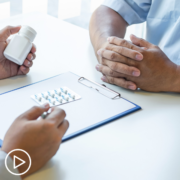
|
Transcript:
Katherine:
Dr. Sen, you are a leading researcher in the field. What is the latest research news that you can share with us about small cell lung cancer?
Dr. Sen:
There’s a lot of great research going on in my lab and labs all across the world. I think for the first time in a very long time, we are really trying to dissect the biology of small cell.
It has been a research in making for many years. I think we have now really come to a point where we are really trying to understand the disease. I’ll go into a little more about the questions you are trying to answer. So, one of the main questions or one of the main things that kind of is a hurdle to getting durable treatment options is that the frontline chemotherapy and immunotherapy doesn’t work as well as they should even for the approved regimens, which is the chemotherapy and the immunotherapy.
The patients often do not have durable benefits. Even if patients have durable benefits, it’s only in a very minority of patient population which means in only about 10 to 15 percent of the total patient population actually do have any benefit from the frontline treatment. So, the main question that we are trying to answer is that why do these patients not respond to immunotherapy and chemotherapy in the frontline.
What are the mechanisms of resistance to chemotherapy and immunotherapy? Primary resistance, what I mean by primary resistance is that patients who never respond. The disease comes back even while they’re getting the frontline chemo. So, the primary resistance, the mechanisms. Of course, when they have acquired resistance after the maintenance regimen when they come back, why are these patients having this acquired resistance to chemotherapy and immunotherapy? Because only when we understand resistance mechanisms will we be able to then come to the combination strategies.
That’s the next area of research is that once we understand the mechanism of chemotherapy and immunotherapy resistance is then coming up with effective combination therapy. So, what should we combine with immunotherapy in order to make immunotherapy better? I’ll give you an example from the research that we did.
So, our lab focus is, as I said, on making immunotherapy better. What we understood is that there are certain epigenetic modifiers like LSD1.
Repressing these, repressing LSD1, with a small molecule inhibitor actually augments or benefits the response to immunotherapy. So now, we are looking at LSD1 inhibitors in combination with immunotherapy. That’s one area that we are focusing on. The second are that we published extensively on is DNA damage response inhibitors which really works in combination with immunotherapy and makes immunotherapy response better.
Now, we are investigating that in the lab the combination strategies of combining these DNA damage response inhibitors with immunotherapy. So, combination strategies. I think always coming up with novel targets. I will mention there are many novel targets that are right now in the clinical trials actually showing really, really encouraging data.
I’m talking about DLL3 targeted BiTEs or ADCs we have seen that are showing preliminary data. We have seen a really good really good response in patients. So, finding these targets that are very specific for small cell and that can work in these unique population of patients.
So, DLL3 targeted agents. There are agents that target B7-H3. So, we are looking at these novel targets and where they could fit in the current therapeutic regimen. Finally, since small cell lung cancer is not a surgical disease, we have to look for other options to find biomarkers. So, liquid biopsy. Liquid biopsy, what I mean by that is understanding the disease not just from tissue but also from blood.
There’s a lot of research that’s happening in understanding the biology of small cell from blood draws from these patients.
So, the field of using liquid biopsy or understanding the disease from blood draws is one of the areas that many labs, including ours, are focusing on, and how we can utilize these blood samples to then monitor the disease and also understand the resistance mechanisms to various drugs. I think these are the areas that we are investigating and seems, to me, very important areas that we need to address in order to really manage small cell lung cancer.
Katherine:
What do these advances mean for small cell lung cancer patients? Are you hopeful?
Dr. Sen:
Oh, yes. Of course. We’re always hopeful. That’s the goal, right. The goal is to have effective therapies that work and that works for a long time. That also benefits the patients in terms of quality of life which means without very severe adverse effects.
So, very hopeful. Because I think what was limiting us for all those years for the last 40 to 50 years is that we really did not understand the complexity of small cell lung cancer. It is a very complex disease. It is very different from non-small cell lung cancer which has these mutations that you can target drugs against. So, there are this EGFR mutations and KRAS mutations in non-small cell.
But small cell, it’s not that. It is not a disease where we have these GATA function mutations that we can devise therapies against. It’s a very different disease. The disease is aggressive. The disease progresses fast, and it also changes its physiology very fast. So, I think for the first time, we really are trying to understand the biology. What that helps is then to come with very informed decisions about therapy.
So, yeah, I’m very hopeful. Because I think we have now targets that we are actually seeing benefits in patients. I think the more and more we understand resistance mechanisms, we’ll also be able to manage that better.
Katherine:
That’s very promising news.
Exploring Renal Cell Carcinoma Research: Expert Insights on Immunotherapy and Targeted Therapy
Exploring Renal Cell Carcinoma Research: Expert Insights on Immunotherapy and Targeted Therapy from Patient Empowerment Network on Vimeo.
What’s important in renal cell carcinoma research news? Expert Dr. Moshe Ornstein from Cleveland Clinic shares an overview of research updates on immunotherapy, targeted therapy, and combination therapies.
See More from START HERE Renal Cell Carcinoma (RCC)
Related Resources:
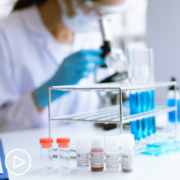
Renal Cell Carcinoma Clinical Trials | A Deep Dive into the Latest Advancements |

|
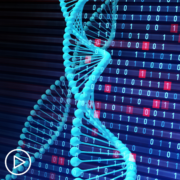
Expert Insights into Kidney Cancer Risk Factors and Genetic Testing |
Transcript:
Lisa Hatfield:
Dr. Ornstein, can you speak to the latest news in renal cell carcinoma?
Dr. Moshe Ornstein:
So just by way of a 30,000 foot view, when it comes to renal cell carcinoma, approximately two-thirds of patients are diagnosed when the cancer is in a localized stage, where the cancer is treated with curative intent, generally with surgery. For patients who present with metastatic kidney cancer, in other words, kidney cancer that has spread beyond the kidney, or for patients who had their kidney removed and then developed a recurrence or the cancer had come back to the lungs or the bones or anywhere beyond the kidney, those patients are treated with what’s called systemic therapy. Those are medicines that really cover head to toe, not a specific area, but head to toe.
And when we think about treatment options in kidney cancer, there are two main treatment options. One is immunotherapy. Immunotherapy is generally what’s called checkpoint inhibitors. And these are therapies that “release the brakes” on the immune system, and allow the body’s immune system to be activated to target the cancer.
And the other type of medicine is called targeted therapies. And these for the most part, are vascular targeted therapies, and the way I describe it is they shrink the blood supply to the tumors. So again, you have those tumors that are diagnosed at a local stage. You have those tumors that are metastatic or advanced beyond the kidney. And the main treatment paradigms have to do with immunotherapy and targeted therapy.
So we just had the ASCO GU meeting, and I just want to describe the updates and how they fit into sort of the overall treatment paradigms across the different treatment sections, in other words, localized and metastatic. So for a patient who presents and comes in with just a kidney mass, that’s a kidney cancer, generally that patient’s going to be treated with surgery. In general, there’s no rule for therapy before surgery. For many years, for that patient who had their kidney cancer removed from the kidney, either part of the kidney or the whole kidney removed, we really didn’t know what to do with those patients, and the standard of care was just to watch those patients.
And we’ll get into a discussion about what watching the patient means. But one of the updates from the recent meetings has been that for patients who have their kidney removed because of kidney cancer, there is now a rule in some patients, this has to be a discussion with the doctor, to use immunotherapy to help prevent or delay the cancer from coming back. It’s a personal discussion.
We have a lot of data to support the use of a medicine called pembrolizumab (Keytruda), which is an immunotherapy that patients would get for a year after their kidney surgery. So that’s really the big recent update in the localized kidney cancer world, where the kidney cancer has been removed by surgery, and there’s now a treatment option, a year of immunotherapy after surgery for the right patient. So now, we move to the metastatic patient.
So again, the patient who has metastatic disease, either comes in with metastatic disease upfront, meaning the kidney’s there, the tumor’s in the kidney, and there’s advanced disease. And the other type is the patient who had their kidney removed a year ago, two years ago, sometimes five years ago, and now shows up with new spots in the lungs or the bones or elsewhere in the body. And that is metastatic or advanced kidney cancer.
So by and large, the overwhelming majority, and in my clinical practice, 95 percent of these patients are going to get an immunotherapy-based regimen as the first treatment for advanced kidney cancer. And there are different types of immunotherapy-based regimens. There’s an immunotherapy in combination with immunotherapy, and that’s called ipilimumab (Yervoy) and nivolumab (Opdivo), so double immunotherapy, or an immunotherapy plus a targeted therapy.
Lisa, we spoke about the targeted therapy, cutting the blood supply. So in addition to getting two immunotherapies, some patients won’t get two immunotherapies, they’ll get one immunotherapy in combination with a targeted therapy. And those combinations include axitinib (Inlyta) and pembrolizumab, lenvatinib (Lenvima) and pembrolizumab and cabozantinib (Cabometyx) and nivolumab as the primary combination treatments for the first line of therapy for metastatic kidney cancer.
And the real updates from the recent meetings in this setting is just that with additional follow-up, in other words, we’ve seen follow-up at two years after the trial started, three years, four years, now five years, we’re seeing that there’s a subset of patients that continue to benefit with this combination years down the road. So, encouraging for patients. Again, it’s not every patient, different patients need different things, but just the knowledge that we have long-term follow-up data for patients who have gotten an immunotherapy-based combination for the front-line treatment for their advanced kidney cancer.
And the last update I want to touch on is once we move beyond that first line of immunotherapy-based combinations, we really don’t know exactly what to do beyond that. Meaning, if somebody got an immunotherapy-based combination, and then the kidney cancer got worse, what do we give next? And generally, we’re giving more of these vascular inhibitors, these targeted therapies. And the latest advancement in this area, in the refractory setting, in other words post immunotherapy-based combination is the introduction of a new medicine called belzutifan (Welireg), which is not a classic vascular inhibitor, but is something called the HIF-2α inhibitor.
It’s a very well-tolerated therapy in many of the patients. And it does have activity in the right patient. And it’s now FDA-approved relatively recently for patients who have already had an immunotherapy-based combination. So that’s kind of the major update. The post-surgery treatment with immunotherapy, long-term data for immunotherapy-based combinations in the metastatic setting, and a novel therapy, a new mechanism of action with a pill with a therapy called belzutifan for patients whose kidney cancer is getting worse despite standard treatments upfront.
Share Your Feedback
Create your own user feedback survey
Understanding Immune System Recovery Post Follicular Lymphoma Treatment
Understanding Immune System Recovery Post Follicular Lymphoma Treatment from Patient Empowerment Network on Vimeo.
Follicular lymphoma treatment may impact the immune system in different ways. Expert Dr. Kami Maddocks from The Ohio State University Comprehensive Cancer Center discusses how immune function may be impacted and how recovery is monitored.
See More from START HERE Follicular Lymphoma
Related Resources:

|

|
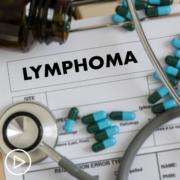
|
Transcript:
Lisa Hatfield:
So another person is asking, “How long does it take for the immune system to really start bouncing back after follicular lymphoma treatment? And what blood test results indicate a weakening immune system?”
Dr. Kami Maddocks:
Yeah, so this is a great question. It also can be a complicated question with many different answers. So one, it can depend on the treatment that a patient receives. Two, it can actually depend on their different parts to the immune system. So different parts of the immune system can recover at different time periods from treatment. So acutely, our neutrophils are something that often gets…they’re bacteria infection fighting cells. Those are the cells that during chemotherapy, when that count gets low and patients are counseled on if you have a fever during your treatment, you need to be evaluated and be seen because if you have an infection and a fever during chemo or some of these treatments, your blood counts are low, you might need to be in the hospital on IV antibiotics.
So those neutrophil parts of it are usually quicker to recover, so they drop with treatment and then recover pretty quickly with each cycle, including after an ended treatment cycle. Sometimes when patients have been treated with several different therapies, it can be harder for those cells to recover. They can stay lower for longer. Then there’s a component of the immune system, so we are ripping out the lymphocytes, because that’s what the cancers have.
And so things targeted. Chemotherapy in general kills the lymphocytes, but there also are targeted therapies like rituximab (Rituxan) bispecific antibodies CAR-T cells, those are particularly wiping…targeted towards proteins on the lymphocytes and wiping them out. Those can be for a more prolonged time. In general, we usually think of about a six-month period so patients can be at increased risk for viral infections in that six-month period may not respond as well to vaccines in that period.
But for some patients it takes longer and some patients recover quicker. It also can depend on where patients are at in their journey because every therapy that they’ve had can take a little bit longer to recover. The last part I’ll add is just sometimes when the lymphocytes are wiped out for a long time people’s proteins, their immunoglobulins that help fight infection get low. And so sometimes we actually will end up giving patients replacement of IVIG to help if they’re having lots of infections.
Share Your Feedback:
Create your own user feedback survey
An Overview of Current Gastric Cancer Treatment Options
An Overview of Current Gastric Cancer Treatment Options from Patient Empowerment Network on Vimeo.
Treatments for gastric cancer have expanded in recent years, providing new options for patients. Dr. Yelena Janjigian, a specialist and researcher, shares an overview of available gastric cancer therapies and outlines the different treatment classes.
Dr. Yelena Janjigian is Chief of Gastrointestinal Oncology Service at Memorial Sloan Kettering Cancer Center.
See More From INSIST! Gastric Cancer
Related Programs:
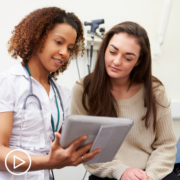
|

Factors to Consider When Choosing a Gastric Cancer Treatment Approach |

How Do Biomarker Test Results Impact Gastric Cancer Treatment Options? |
Transcript:
Katherine:
Okay. I’d like to move onto current gastric cancer treatment options. Can you provide an overview of what’s available now?
Dr. Janjigian:
Right. So, in patients with intermediate or early-stage tumors, really surgery is the main way to cure patients. Occasionally when we have an amazing response to chemotherapy or chemotherapy with immunotherapy or just immunotherapy, we can avoid surgery. But in most patients, surgery in early-stage disease is a gold standard for cure. Of course, it can be a very jarring thing to say to someone. “We have to take out. your stomach.” But patients do live without either fully their stomach removed or partially removed. And that’s the gold standard. We do additionally other treatments to help maximize chances of cure, but surgery is the main state. As I mentioned earlier, most of our patients, however, present with later stages where surgery is not feasible.
And when I say it’s not feasible, we would only attempt an operation if we thought there was a possibility of removing the cancer completely. Leaving some of the tumor behind, even if it’s only 1 percent of the cancer behind, makes patients unwell. They may not be able to tolerate additional chemo, so we do not recommend doing suboptimal surgery unless cancer can be completely removed. So, in those patients, we always explain the situation.
And the disease is not potentially as curable, but it’s absolutely always treatable. And since the development of our immunotherapy options, really, we’ve changed the trajectory and the course of those cancers. We won’t know the stage or the final response to therapy until we’ve start it. But in those patients, usually a form of long-term therapy. Chronic treatment is very important.
And usually it involves a combination of chemotherapy and some targeted agents, biologic agents, meaning that they were designed in the lab to target the cancer specifically. And usually, they involve some sort of immunotherapy.
Katherine:
Excuse me. Can you go into some detail about the targeted therapies and immunotherapies that you use?
Dr. Janjigian:
Sure. So, conventional chemotherapy works on any rapidly dividing cell. And these are chemotherapies that have been tried and true in the clinic for decades, right? And they work still in gastric. And in particular they’re very important. And then over the last 10 years or so, we’ve started developing target agents in the lab that target the specific biologic tumor biomarkers. And when you think about tumor biomarkers, I would think about them as almost ZIP codes, right? How do you direct the cancer cell to die?
And how do you inhibit the cancer cell for the thing that is uniquely what’s making it grow as opposed to normal cells, right? So, that’s the difference between chemotherapy because chemotherapy can affect any rapidly dividing normal cell and cancer cell, while biologic agents ideally only affect the target, cancer, the cell. So, that’s why it’s very appealing to do both to help maximize response and survival on treatment. So, the biologic therapies that are available in and already approved in our disease for stomach cancer are something called HER2 directed treatments.
And that’s been my focus in the lab. And then in my group has really spearheaded a lot of this research for HER2-positive tumors. In gastric cancer it occurs in up to 20 to 30 percent of tumors, but we have drugs such as trastuzumab or Herceptin, T-DXd, trastuzumab deruxtecan-nxki (Enhertu) or in HER2 that target these agents.
And furthermore, our work here at Memorial Sloan Kettering demonstrated the combination therapies really for HER2-positive disease has helped improve outcomes in those patients. So, that’s biologic therapy. Other biologic therapies that’s approved in gastric cancer is something called VEGFR-2 inhibitor. These are drugs that target blood vessel formation around the tumor to help the chemotherapy drugs work well and better. Those drugs are called ramucirumab or Cyramza. And that’s used in a combination of chemotherapy in second-line treatment. And there’s other drugs such as regorafenib (Stivarga) and other inhibitors that maybe have some targetable activity in our disease. And last but not the least is immunotherapy. So, immunotherapy’s a completely different class of drugs.
We think about immunotherapies, really the fundamental problem with cancer, right? The cancer issues that it started as a normal cell. So, at some point, it was a normal cell that then became and went awry and went rogue. And the body did not recognize that there was a problem. And the immune system did not eliminate that cancer cell. Before it started to metastasize and give us problems in their body, right? So, the fundamental question is why is the body’s immune system, why did it not recognize it as a abnormal cell?
Well, because it really acts and looks like a normal cell from the immune perspective. Our immune system is trained not to hurt us, right? And that’s why in patients with rheumatoid arthritis or other autoimmune disorders, what happens is the immune system goes awry. So, what the immune checkpoint blockade or immunotherapy for cancer does, is it helps take some of those brakes off our immune system and help our immune system recognize the cancer and give it permission to say, “Hey, you know what?
You thought it was a normal cell. It’s not. It’s a cancer cell. Please help us eliminate it.” And that’s worked well because I think in for some of our patients, the immune system actually knows how to target and suppress the cancer much better than any of the fancy drugs we can design in the lab.
And that’s why in some patients, immune checkpoint blockade immunotherapy has been such a game changer if you do respond, your duration and durability of response is so much more better than anything that would go to just done on our own in the lab or with other chemotherapies. So, it really is a nice way to think about it. And the patients feel like they’re part of the solutions. It’s always nice for them to have that.
But it’s been a real game changer for both HER2-positive and HER2-negative disease in combination with chemotherapy. I’ve had the pleasure of leading some of these studies. And it’s nice to be able to update the three or the four or the five-year survival rate from these studies in a disease where in the past most patients died within a year.
Accessing Financial Resources for Lung Cancer Care
Accessing Financial Resources for Lung Cancer Care from Patient Empowerment Network on Vimeo.
Is there financial support for patients that need assistance with the cost of lung cancer care? Dr. Erin Schenk shares advice and resources available to help alleviate the financial burden that some patients and care partners may experience.
Dr. Erin Schenk is a medical oncologist, lung cancer researcher, and assistant professor in the division of medical oncology at the University of Colorado Anschutz Medical Center. Learn more about Dr. Schenk.
See More From INSIST! Lung Cancer
Related Resources:
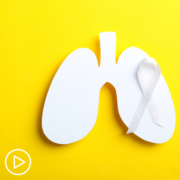
Personalized Lung Cancer Treatment | Key Factors to Consider |
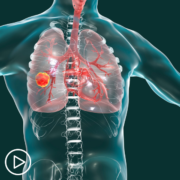
|

|
Transcript:
Katherine Banwell:
You know, one thing patients are often concerned about is the financial aspect, the financial burden that is involved in their treatment care. How do they deal with that? Are there resources available for them?
Dr. Erin Schenk:
There can be and this definitely can vary based on what treatment you’re being given and where you are, at what institution and what state you’re being treated at since resources are different. But for example, the targeted therapies or the TKIs I made reference to earlier, those can have some significant out-of-pocket costs and most of the, if not all of the manufacturers of those various TKIs have patient assistance programs that help to reduce the out-of-pocket costs for those specific medicines.
When I prescribe a TKI for a patient often what’s part of that is a prior authorization to try to understand what’s the out-of-pocket cost for the patient and then kind of get on top of whether or not we need to apply for patient assistance to help pay for the cost of that medication. So, that’s one way that we can help.
I think, in again, this is specific to my institution and our clinical practice, but we often have – we work very closely with other cancer doctors in the community. So, if traveling to our site is a major burden we can usually have them visit with a oncologist who’s close to them so there’s less travel, there’s less costs in you know gas and staying somewhere. But they still can be connected with us. So, while they can get most of their care under a doctor that’s closer to them, every so often they come back and see me and just talk about how things are going and what you know might be worthwhile to consider down the road.
And I would also recommend that if there are other costs or concerns you know, kind of above and beyond these things that we’ve touched on, connecting with a social worker through the cancer center can be helpful in dealing with paperwork for disability or retirement or sometimes connecting to resources if there’s a childcare need.
Or you’re caring for a spouse and you need additional help at home. You know all of the different burdens that are present in life that just get magnified with a cancer diagnosis and you know, we can – there’s usually a really big attempt to try to find a way to help figure out navigating those so that you can get the care you need.
Small Cell Lung Cancer Care and Outcomes in Underrepresented Communities
Small Cell Lung Cancer Care and Outcomes in Underrepresented Communities from Patient Empowerment Network on Vimeo.
How does small cell lung cancer (SCLC) care look in underrepresented communities? Dr. Rafael Santana-Davila with the University of Washington School of Medicine explains how health outcomes differ in some ZIP codes and shares advice for questions to ask your doctor to access optimal SCLC care.
[ACT]IVATION TIP
“…patients should ask their doctors, ‘What are the latest advances in this disease? Am I eligible for it to receive those advances? And where can I see a sub-specialist in this disease? And is it a worthwhile point?’”
See More from [ACT]IVATED Small Cell Lung Cancer (SCLC)
Related Resources:
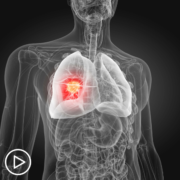
|

|
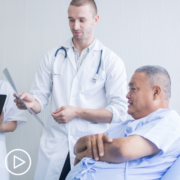
Key Resources for Small Cell Lung Cancer Patients and Families |
Transcript:
Lisa Hatfield:
Does treating small cell lung cancer patients in underrepresented communities look different than the general population? And are there specific considerations or recommendations SCLC patients from underrepresented communities when it comes to treatment options, including clinical trials or targeted therapies?
Rafael Santana-Davila:
In the majority of cases, patients treated in underrepresented communities do not look different than in the general population in small cell lung cancer. Why? It’s because community oncologists are very good. So they have a hard job, but they’re very good. So the majority of patients get the standard of treatment.
Although we know though that patients with underrepresented communities do fare worse. And we do not know the reasons for that. A lot of that is because of poverty or many other things. I’ve seen people say that one of the main factors that will determine how long you live is what ZIP code you were born in. So underrepresented communities do do worse in general, not specifically for small cell, but in general.
I do think that what we..like we said before is what patients need to do is advocate for themselves and ask their doctors, “Am I eligible for a clinical trial? Am I eligible for what is the latest and greatest for the disease? Any new advances that you see coming?”And like we said before is seek a second opinion with a sub-specialist in the treating of this disease.
So as like we said before in terms of activation, is you need to…patients need to ask their doctors, “What are the latest advances in this disease? Am I eligible for it to receive those advances? And where can I see a sub-specialist in this disease? And is it a worthwhile point?” Many times it may not be an initial diagnosis, but when patients have recurring disease, that’s when clinical trials are really important because that’s where we’re making the most advances in the treatment of small cell lung cancers, when patients have disease that has recurred despite chemo-immunotherapy.
So my activation tip for this is that patients should ask their doctors, “What are the latest developments in the treatment of this lung cancer? And am I eligible to receive those treatments? And is this a time where I should seek a second opinion or be referred to a clinical trial and another center?”
Share Your Feedback:
Create your own user feedback survey
What Are Treatment Options for Endometrial Cancer?
What endometrial cancer treatment options are currently available? Endometrial cancer expert Dr. Emily Ko shares an overview of options, including chemotherapy, surgery, radiation, targeted therapies, combination therapies, hormonal therapies, and discusses considerations for patients who are trying to preserve their fertility.
Related Programs:

|

|
Transcript:
Katherine:
I’d like to talk about the treatments that are currently available. You mentioned chemotherapy, but what else is available for people?
Dr. Ko:
Absolutely. So, treatment for endometrial cancer is usually some combination of surgery, and then it may be followed by possibly chemotherapy, as well as radiation, and sometimes, it may be a combination of all three treatments, or sometimes, it’s a combination of one or two of those, depending on the exact stage, depending on the exact cell type, and some of the other factors.
Katherine:
Are hormonal therapies used as well, and targeted therapies?
Dr. Ko:
Yes.
Katherine:
I know they are in other cancers.
Dr. Ko:
Yes. And so, I think the question is where do those come into play? So, I would say the usual algorithm most commonly would be that surgery is done first, as the most common first step, and then, based on the information obtained from surgery and the pathology report that comes from that, then there’s usually some type of a recommendation about should there be a second stepped treatment, and that frequently can be chemotherapy/radiation.
Now, the areas where targeted therapy – for example, immunotherapy – where does that come in? So, that now has come into the – I would call it the second stage. We’re combining it with the classic chemotherapy drugs – Taxol-carboplatin, for example. That’s one example where it could come into play. Another example could come into play where a patient had gone through classic Taxol/paclitaxel and carboplatin, then had cancer come back, and so, that could be another instance where that pembrolizumab or pembro with lenvatinib (Lenvima) combination can be used in the setting of recurrence.
Now, we could also say, hey, if your cancer type has those hormonal receptors present or is some type of what we call endometrioid histology, and we think that hormonal therapy may be more effective in that case, then that could also be used in a setting where the cancer has kind of grown again, the cancer has grown back, or actually, there are certain situations where patients, for example, may not undergo a hysterectomy.
And, there are unique cases and those situations where patients are still trying to preserve their fertility, and therefore not wanting to undergo a hysterectomy, or they’re unable to undergo surgery safely. And so, in some unique situations, we may also use hormonal therapy as the mechanism to treat their cancer, and whether that is by way of a pill, whether that is by way of a progesterone intrauterine device, IUD, that is placed into the uterus, we also have situations where we tailor the therapy to the condition of the patient.
Katherine:
When treating more advanced endometrial cancer disease in general, are the treatment options different than if you were treating somebody who had stage I or stage II, for instance?
Dr. Ko:
Sure, great question. So, for some patients with, say, stage I, surgery alone is enough.
For some other patients, subcategories of stage I, where we call them more high/intermediate-risk patients, they’re stage I, but there are a few features about their pathology that might make them slightly higher risk for recurrence – in those cases, we might consider a little bit of radiation after surgery, what we call adjuvant radiation or what we call radiation vaginal brachytherapy. Just three short treatments of a little bit of radiation to the top of the vagina has been shown to possibly decrease chance of recurrence in that area with very minimal side effects.
So, that would be more commonly in line with stage I. There are some subtypes that can still be what we call high-risk, even in stage I/stage II uterine serous carcinoma, uterine carcinosarcoma. In those cases, we might also recommend chemotherapy along with some vaginal brachytherapy following their hysterectomy, so that’s the early stage.
And then, with the advanced stage, yes. So, frequently, it’d be surgery first to secure the diagnosis, followed by some type of – it might be primarily chemotherapy, or it could be combination chemotherapy with radiation. And over time, I would say our paradigm for what we use for chemotherapy and radiation has changed a little bit.
If you go back a couple decades, I think radiation was used a lot – whole pelvic radiation, even just without any chemotherapy. And then, we then had more data from research clinical trials, GOG-258 or PORTEC-3, that then had given us evidence that perhaps doing chemotherapy with some combination of radiation is going to be beneficial, or even moving towards primarily radiation could be a very good option in terms of long-term benefit/long-term survival.
And, of course, that brings us to the present day, those two trials that I mentioned from ASCO, the GY018 and the RUBY, now bringing in the immunotherapy component to the chemotherapy, so there has definitely been an evolution to managing advanced stage.
Recent Advances in Treating Breast Cancer
Recent Advances in Treating Breast Cancer from Patient Empowerment Network on Vimeo.
What are the latest breast cancer treatment and research advances? Expert Dr. Bhuvaneswari Ramaswamy shares treatment updates for specific breast cancer types and discusses testing for circulating tumor DNA.
Dr. Bhuvaneswari Ramaswamy is the Section Chief of Breast Medical Oncology and the Director of the Medical Oncology Fellowship Program in Breast Cancer at The Ohio State College of Medicine. Learn more about this expert here.
See More from Thrive Breast Cancer
Related Resources:

|

|

|
Transcript:
Katherine:
Are there emerging therapies that are showing promise?
Dr. Ramaswamy:
Oh, my God. There’s just tremendous emerging therapies that are showing extraordinary progress. And I talk about this to my patients all the time. I mean, I tell them like two years ago say in a patient with – patient with metastatic disease, I’ll say, last year this drug wasn’t approved.
This drug is now approved for you to be given, and it shows extraordinary effect. So, every year we have new drugs getting approved, and we are also trying to get it used to be a little bit of a richness on the HER2-positive disease. And now we are seeing definitely a lot of richness on hormone receptor-positive disease. And I think we’re starting to see some new particular immunotherapy and other targeted therapies showing some response in triple-negative breast cancer.
Now, I know that’s a place that we still need to see more newer therapies, but overall, in the stage IV setting, we have really many options to keep them in good quality of life and longer. But people will ask, “Really, why do I even need to get to stage IV?” Really look at me and improve the curative setting. And that again, we are able to pick the higher risk patients, what me – what it means to have higher risk disease, how do we target them, newer drugs to target them. So, I think in so many ways we are doing better. And we are also getting to a place can we detect higher-risk patients, not just by their initial diagnosis and response, but follow them sequentially by circulating tumor cells?
And we are getting to that place where we can actually do circulating tumor DNA, so just isolate the DNA, and we know what will belong to the tumor. And then circulating tumor cells seemingly even after your curative therapy. And so that is something that’s getting approved. And so we are not only seeing treatment, but we are also trying to see better detection of that reference. So, I think we are in so many ways, improving. And I am – I’ve been in this for 20 years, some of the things that thought was a dream is coming true. So, truly just keep living well and keep thriving. There are options.
Katherine:
Yeah. That’s, it’s positive.
Dr. Ramaswamy:
Yes.

